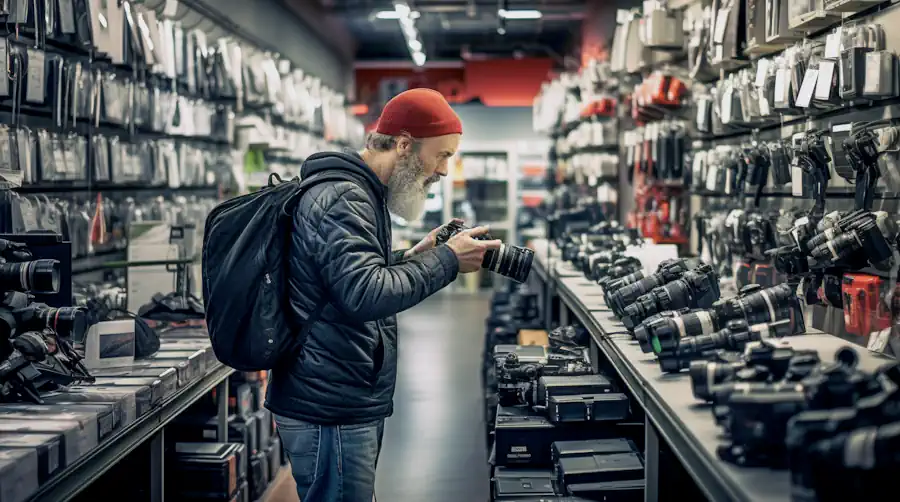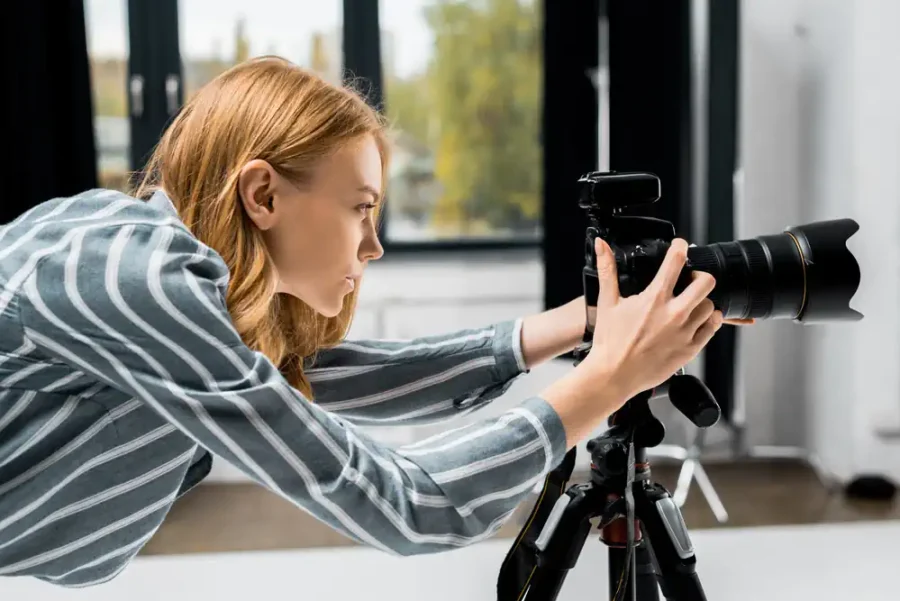Imagine you’re a chef in search of the perfect knife; it’s not just about the sharpness, but how it balances in your hand, the quality of the steel, and its versatility with various ingredients.
Similarly, as a professional photographer, you’re in pursuit of a camera that not only captures sharp images but also embodies a fine balance of functionality and artistic control. You need a tool that responds to the subtleties of light and shadow with a sensor that can articulate the nuances of your vision. You weigh the autofocus speed and accuracy, the heft and build of the body, and the ecosystem of lenses at your disposal.

But beyond these technical specifications, you’re also considering the less tangible elements—how the camera feels in your hands, the ease with which you can navigate its menu system, and how it enables you to translate fleeting moments into lasting impressions.
So, what exactly sets apart the cameras that make the cut, and why should you, as a discerning professional, pay close attention to these details?
Let’s examine the critical features that stand at the forefront of a professional’s choice, features that might just redefine the way you capture the world.
Key Takeaways
- Professional photographers prioritize image quality and resolution, seeking cameras with large sensors for high dynamic range and sharp images. They also look for cameras that maintain image quality at high ISO settings, such as the Canon EOS 5D Mark IV and Nikon D850 with expansive ISO ranges. Additionally, the demand for 4K resolution is met by cameras like the Canon EOS R5 and Sony A9 Mark II.
- Autofocus performance is crucial for professional photographers, who require swift and accurate autofocus systems that consistently perform well across various scenarios. Advanced tracking capabilities and reliable autofocus, even in low light conditions, are highly valued in cameras from Canon, Nikon, and mirrorless systems.
- Build and durability are essential features for professional photography. Weather-sealed construction protects cameras against rain, dust, and humidity, while a robust and durable design ensures longevity. In-body image stabilization, extended battery life, and dual memory card slots for uninterrupted shooting are also sought after by professional photographers.
- Ergonomics and usability play a significant role in camera selection. Professional photographers prefer cameras with intuitive button placement, a comfortable grip, and quick access to advanced features. Seamless interaction with specialized gear, like tilt/shift lenses, is also important. Ultimately, the camera should feel like an extension of the hand, allowing photographers to focus on creativity without hindrance.
- Lens system compatibility is a key consideration for professional photographers. They assess the availability of lens mounts and adapters for integration with their existing equipment. The versatility of the camera is impacted by the range of lens options, including prime, macro, trinity, and wide-angle lenses. Compatibility and flexibility with the Canon EOS R system, as well as cross-compatibility with other camera platforms and adapter availability, are factors that professional photographers take into account when choosing a camera.
Image Quality and Resolution
Professional photographers often prioritize image quality and resolution, knowing that these elements are the bedrock of stunning, detail-rich photographs. A large sensor, like a full-frame sensor, is key to achieving a high dynamic range and tack sharp images.
When you’re knee-deep in low-light situations, a camera that maintains image quality at high ISO settings, without compromising detail, is indispensable. The Canon EOS 5D Mark IV and Nikon D850 are exemplary, with their expansive ISO ranges allowing you to capture the scene as your eyes perceive it, even at base ISO.
Moreover, the leap into 4K with the Canon EOS R5 and Sony A9 Mark II isn’t just about keeping up; it’s about delivering a resolution that keeps your work at the forefront of innovation.
Autofocus Performance
A photographer’s ability to swiftly and accurately capture a moment hinges on the camera’s autofocus performance, a feature that’s become indispensable in the fast-paced world of professional photography. You demand an autofocus system that locks onto subjects with speed and precision. Whether you’re using a Canon EOS 5D Mark IV, a Nikon flagship, or a cutting-edge mirrorless camera, the autofocus performance must be consistent across various scenarios—especially in low light.
When professional photographers use these tools, they expect the camera body and lens to work in harmony, delivering images that are sharp where it counts. Systems with advanced tracking capabilities are paramount, ensuring that the focus evolves seamlessly with the motion of the subject. Whether it’s a Canon or Nikon in your hands, the autofocus mustn’t falter.
Build and Durability

Beyond the technical prowess of a camera’s autofocus lies the imperative of robust build and durability, ensuring your gear withstands the unpredictable nature of professional assignments. As a professional photographer, you demand a camera that can handle whatever’s thrown its way.
Weather Sealed Construction
- Protection against rain, dust, and humidity
- Enables shooting in diverse environments
Ergonomic and Durable Design
- Sturdy construction for the rigors of professional photography
- Comfortable handling with intuitive buttons and dials
Models like the Canon EOS 5D Mark IV exemplify this resilience with their rugged frames. You appreciate in-body image stabilization for those high frame rates and a sensor size that doesn’t compromise image quality. Moreover, features like extended battery life and dual memory card slots ensure you capture the moment without interruption.
Ergonomics and Usability
While rugged build and durability ensure your camera survives the demands of the field, the ergonomics and usability dictate how seamlessly you interact with your equipment during those critical moments of capture. As a professional photographer, you’re seeking a professional camera that feels like an extension of your hand.
Intuitive button placement and a comfortable grip are essential when you’re carrying around photography equipment for long hours. You want quick access to advanced features and customizable controls that don’t require fumbling through complex menus. Your camera and lens setup, especially when working with specialized gear like tilt/shift lenses, must enhance, not impede, your overall performance.
Ultimately, ergonomics and usability aren’t just about comfort; they’re about enabling your creative vision to flourish without technical hindrances.
Lens System Compatibility
You must consider the breadth of lens options available when choosing a camera system. This impacts the versatility of your equipment.
Assess the mount and adapter availability to ensure you can integrate various lenses with your camera for optimal image quality and sharpness.
Range of Lens Options
A camera’s lens system compatibility is a crucial aspect for professional photographers, as it allows them to select the ideal lens for any given photographic challenge, whether it’s capturing the intricate details of a macro shot or the expansive beauty of a landscape.

Range of Lens Options:
- Prime lens: Exceptional sharpness and large aperture for shallow depth of field.
- Macro lenses: Capture minute details with precision.
- Trinity of lenses: Essential range covering wide-angle to telephoto focal lengths.
- Wide angle: Broaden the horizon, ideal for landscapes.
Models like the Canon EOS R offer extensive compatibility, pairing beautifully with lenses that leverage large sensors to their full potential. You’ll appreciate the flexibility and creative freedom this range of lens options provides, ensuring you’re equipped for any photographic endeavor.
Mount and Adapter Availability
Mount and adapter availability significantly broadens your photographic arsenal, permitting the use of diverse lenses across various camera platforms. When you’re eyeing a Canon EOS 5D Mark IV or delving into the mirrorless realm with a Canon R, the ability to interchange lenses—be it Canon’s own or from different camera manufacturers—can be a game-changer.
Nikon enthusiasts, wielding a Nikon D series or exploring their mirrorless options, also rely on this flexibility. Adapter availability for systems like Micro Four Thirds further enhances your creative potential, allowing the incorporation of lenses not originally designed for your camera.
This cross-compatibility isn’t just a convenience; it’s a strategic asset in your pursuit of innovation, ensuring you have the right tool for every photographic challenge.
Image Quality and Sharpness
For professional photographers, lens system compatibility is paramount in capturing images with the highest quality and sharpness.
- Lens Quality and Compatibility
- You’ll want lenses that enhance clarity and offer minimal distortion, especially when you’re investing in full-frame cameras or medium-format mirrorless systems.
- The Canon EOS 5D Mark, particularly the EOS 5D Mark IV, is renowned for its lens compatibility, opening up a world of photographic possibilities.
- Camera Features
- Look for Mark IV features that support high frame rates and exceptional low-light performance.
- The best cameras for professional use not only deliver image quality and sharpness but also provide the flexibility to create beautiful bokeh and manage depth of field with precision.
Your craft demands innovation, and your gear should match that ambition.
Advanced Features and Customization
Professional photographers often demand advanced features and customization in their cameras, enabling quick adjustments and precise control over their shots. You need a camera that can handle the spontaneity and varied demands of professional work. This is where customizable control dials and extensive focus points become indispensable. Professionals use these to tailor autofocus for the best possible shot in any scenario.
Durability is non-negotiable; hence, features like weather-sealing are a must. Full-frame cameras, like the Canon 5D Mark IV, are renowned for their robustness and versatility. As for flexibility, the Perfect Trio of Nikon excels, offering compatibility with a plethora of lenses and accessories.
Articulating screens enhance Photography Setups to Take unique angles, ensuring you capture every perspective. These advanced features and customization options define the professional camera’s prowess.

As a professional photographer, you crave a camera that’s an extension of your vision, capturing life’s fleeting moments with crystal clarity.
Your ideal partner boasts a robust heart to weather the storm, a touch of intuition in its autofocus, and a symphony of lenses at your fingertips.
It’s not just a tool, but a craftsman’s ally, finely tuned to your personal dance with light and shadow, freezing time with the press of a button.
Your camera is your brush, the world your canvas.
